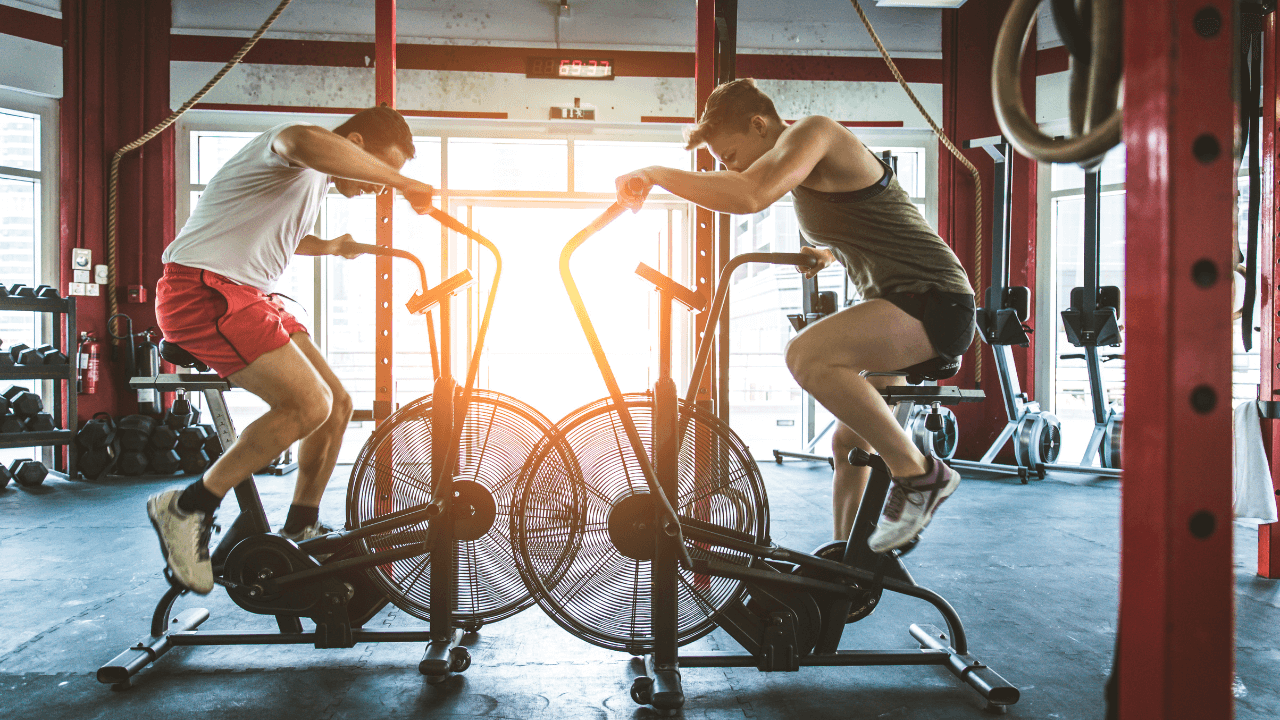Are you looking to improve your daily life, reduce the risk of injury, and move more efficiently through everyday tasks? Functional fitness training could be the answer. This blog post will guide you through the importance of functional exercises for adults, how to build a balanced, functional workout routine, and incorporate functional exercises into your daily life. Get ready to transform your fitness journey and enhance your overall well-being!
Key Takeaways
- Functional exercises for adults are designed to help older adults improve their balance, mobility and strength for everyday tasks.
- Benefits of functional fitness include improved physical health, enhanced mobility & decreased risk of falls/injuries.
- A balanced routine should incorporate warm up/mobility exercises, strength training & cardiovascular activities that mimic real life movements emphasizing the importance of functional exercises for adults.
The Importance of Functional Fitness for Adults
Functional fitness exercises focus on improving daily activities and overall quality of life by targeting multiple muscle groups and joints. These exercises are designed to train and develop muscles to facilitate everyday tasks with greater ease and safety. The objective of functional fitness for seniors is to enhance balance, mobility, and strength for everyday tasks through functional exercise movements.
Keep in mind, older adults with restricted mobility often struggle to perform daily activities. Retirement may cause certain difficulties for seniors, such as:
- pre-existing injuries
- joint stiffness
- muscle tightness
- general debilitation
However, functional exercises can help mitigate these issues by involving multiple muscle groups and joints working together, providing an effective means of enhancing physical fitness in everyday life.
Benefits of Functional Fitness
Functional fitness training can bring about various benefits, such as:
- Improved physical health
- Enhanced mobility
- Decreased risk of falls and injuries
- Higher quality of life
- Decreased stress
- Lower rates of depression
- Increased happiness
- Improved focus
- Enhanced memory
- Improved cognition
Research has been conducted to prove that resistance training helps reduce the risk of falling by 57 percent amongst women aged 75-85. This exercise regimen has beneficial implications for the elderly population.
Walking, swimming, and cycling are excellent exercises for seniors that can improve cardiovascular fitness. In addition, flexibility exercises such as:
- the overhead side stretch
- shoulder stretch
- chest stretch
- supine knee to chest
are all beneficial for increasing flexibility. These exercises, combined with functional fitness training, can greatly improve balance, mobility, strength, and cardiovascular endurance, making daily tasks easier and reducing the risk of injury.
Real-Life Applications
Functional exercises imitate real-life movements, making them effective in enhancing physical function and autonomy. Examples of functional exercises for the upper body include chest press, dip, and various push-up variations. Biceps strength is necessary for the purpose of holding something in front of you or against your chest.
One example of a functional exercise that requires balance is the push-up, which starts from the push-up position. By incorporating balance exercise and other functional exercises that mimic real-life movements, adults can improve their physical function and independence in daily tasks, making their lives easier and safer.
Building a Balanced Functional Workout Routine

A comprehensive and effective functional workout routine should incorporate warm-up and mobility exercises, strength and resistance training, as well as cardiovascular endurance exercises. Functional exercises include inverted rows, kettlebell swings, up-down plank pushups, cross-body clean and press, step-ups, push-ups, walking lunges, jump squats, and side lunges.
Functional fitness training, also known as functional training, emphasizes targeting major muscle groups and mimicking everyday functional exercise movement like:
- squatting
- lifting
- pushing
- pulling
can boost overall physical fitness and add efficiency and enjoyment to daily activities.
Warm-Up and Mobility
Before starting your functional fitness routine, initiate with dynamic stretches and mobility exercises, which prepare your body for functional movements. Warm-up and mobility exercises are designed to prepare the body for physical activity, with the aim of preventing injury and enhancing performance.
Examples of warm-up and mobility exercises include:
- Hip circles
- Arm circles
- Arm swings
- High knees
- Leg swings
- Bear crawls
These exercises, if incorporated into your routine, can serve as an effective warm-up for your muscles and joints, lowering the risk of injury and facilitating a more productive and enjoyable workout.
Strength and Resistance Training
Strength and resistance training form a fundamental part of a functional workout routine. Incorporate exercises that target major muscle groups and replicate daily activities, such as squats, lunges, and push-ups. These exercises not only improve muscle strength but also enhance joint stability and balance, reducing the risk of falls and injuries.
Kettlebell deadlifts can be included in the strength and resistance training component of a functional workout routine, targeting both the biceps and the entire posterior chain. Some benefits of including kettlebell deadlifts in your workout routine are:
- Enhanced physical fitness
- Improved strength and muscle tone
- Increased stability and balance
- Easier performance of daily tasks
Focusing on exercises that emulate everyday movements results in enhanced physical fitness and easier daily tasks.
Cardiovascular Endurance
Cardiovascular endurance forms an integral part of functional fitness training. It is the capacity to sustain physical activity without undue fatigue, owing to the good health of the heart, lungs, and blood vessels. Activities that can be beneficial in improving cardiovascular endurance include:
- walking
- swimming
- cycling
- running
- other rhythmic activities
Enhancing cardiovascular endurance can assist in improving heart health, diminishing the possibility of chronic diseases, and augmenting overall fitness. Be sure to begin gradually and incrementally increase the intensity and duration of your cardiovascular exercises, incorporating warm-up and cool-down routines to ensure safety and effectiveness.
Top 7 Functional Exercises for Adults
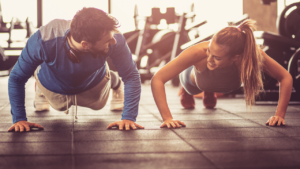
To elevate your functional fitness training further, we’ve curated a list of functional exercises that focus on different muscle groups and movement patterns. These exercises include squat variations, push and pull movements, and core stability exercises, all designed to improve daily living and overall quality of life.
Incorporating these exercises into your daily routine allows you to:
- Fine-tune your functional fitness
- Take advantage of benefits such as improved balance, mobility, strength, and cardiovascular endurance
- Simplify and enhance efficiency in daily tasks.
Squat Variations

Squats are an excellent exercise for targeting the lower body and improving mobility and strength. Bodyweight squats, jump squats, and lateral lunges are all squat variations that target the quadriceps and gluteus maximus.
To perform a squat correctly, follow these steps:
- Start with your feet shoulder-width apart.
- With your knees bent, lower your hips as if sitting in a chair.
- Keep your core engaged and your back straight throughout the entire movement.
Incorporating squat variations into your functional fitness routine can greatly improve your lower body strength and stability, making daily activities like climbing stairs and lifting objects easier and safer.
Push and Pull Movements
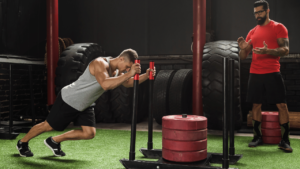
Push and pull movements refer to exercises that involve pushing weight away from the body or pulling weight towards the body, targeting muscles in the chest, shoulders, back, and arms. Exercises like push-ups, rows, and curls can enhance upper body strength and functional ability.
By focusing on these movements and incorporating them into your functional fitness training, you can improve your upper body strength and make daily tasks like lifting objects, opening doors, and carrying groceries more manageable and efficient.
Core Stability Exercises
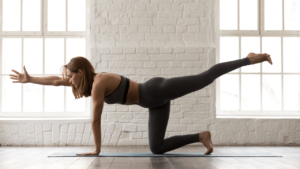
A strong core is vital for daily activities as it offers stability and support to the entire body. Core stability exercises like planks, mountain climbers, and Pallof presses improve core strength and stability, essential for daily activities.
By incorporating core stability exercises into your functional fitness routine, you can:
- Strengthen your core muscles
- Improve your overall balance, coordination, and stability
- Make daily tasks more efficient
- Reduce the risk of injury.
Functional Exercise Equipment and Tools
Selecting appropriate equipment and incorporating it into your routine can significantly boost your functional fitness training. Functional exercise equipment includes:
- Resistance bands
- Kettlebells
- Medicine balls
- Suspension trainers
- Agility ladders
- Balance boards
These tools can help you modify exercises, increase resistance, and improve balance and stability, all essential for optimizing your quality of life and making daily activities more manageable.
Choosing the Right Equipment
Select equipment like kettlebells, resistance bands, and dumbbells to add variety and challenge to your workouts. Balance and core equipment can assist in enhancing balance and coordination, while resistance bands can assist in developing strength and endurance.
Consider your fitness goals, budget, and available space when choosing equipment suitable for you. By choosing the right equipment for your functional fitness journey, you can maximize your results and enjoy a more effective and enjoyable workout experience.
Incorporating Equipment into Your Routine
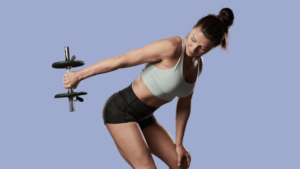
Use equipment to modify exercises, increase resistance, and improve balance and stability. For instance, a resistance band can be employed to make a squat more demanding, while a stability ball can be utilized to make a push-up simpler.
Incorporating equipment into your functional fitness routine enables you to challenge yourself, tailor exercises to your personal needs, and concentrate on enhancing your overall physical fitness and daily activities.
Functional Fitness Training Tips and Safety Considerations
Maintaining proper form and technique, along with modifying exercises as required, are vital aspects of functional fitness training. Focusing on these elements can help prevent injury and yield maximum results.
For optimizing your functional fitness journey, consider starting from a proper starting position and following tips and safety considerations like maintaining proper form and technique, gradually progressing exercises, and modifying exercises to match your individual needs and capabilities.
Proper Form and Technique
Focus on maintaining correct alignment and posture during exercises to reduce the risk of injury. It is essential to keep the core engaged and the back straight throughout the entire movement, whether you’re performing a squat, lunge, or push-up.
Adhering to proper form and technique guarantees accurate and safe execution of your functional fitness exercises, optimizes your results, and prevents injury.
Progression and Modification
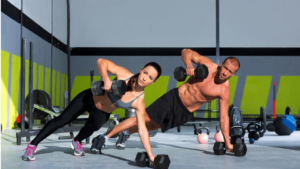
Gradually increase the intensity of your functional fitness exercises and modify them to suit your fitness level and individual needs. Adjustments to intensity, range of motion, and number of repetitions can be made to ensure prevention of injury and attainment of optimal results.
Progressing and modifying your functional fitness exercises allows you to consistently challenge yourself and advance in your fitness journey, thereby improving your overall health and well-being.
Integrating Functional Fitness into Daily Life
Incorporating functional exercises into your daily routine at home and work can greatly improve your overall health and well-being. By integrating functional fitness into your daily life, you can enjoy the benefits of:
- Improved balance
- Increased mobility
- Enhanced strength
- Better cardiovascular endurance
Whether you’re performing exercises during household chores or taking a break at work, functional fitness training can help you make daily tasks more efficient and enjoyable, enhancing your overall quality of life.
At Home
Perform functional exercises during household chores or while watching TV to make daily activities easier and more efficient. For instance, squat while doing laundry, lunge while vacuuming, and perform push-ups while washing dishes.
Incorporating functional exercises for adults into your home routine helps improve your overall physical fitness, makes daily tasks more manageable, and enhances your quality of life.
At Work
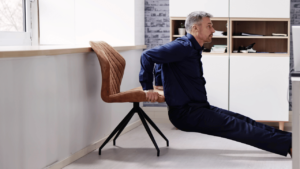
Include functional movements during breaks or lunchtime at work to reduce the risk of injury and improve productivity. Incorporating functional exercises into your work routine enhances overall physical fitness, reduces stress, and boosts focus and energy levels, resulting in a more productive and enjoyable workday.
Summary
Functional fitness training is an essential aspect of improving daily activities and overall quality of life. By incorporating functional exercises for adults, equipment, and safety considerations into your routine, you can optimize your functional fitness journey and enjoy the benefits of improved balance, mobility, strength, and cardiovascular endurance. Take the first step towards a healthier, more functional life today!
You might be interested in: Functional Exercises For Seniors
Frequently Asked Questions
What are the 7 functional exercises for training?
The 7 functional exercises for training are Squat, Hinge, Lunge, Push, Pull, Carry, and Rotate.
What is functional fitness for older adults?
Functional fitness for older adults helps improve balance, mobility, and strength. Exercises such as walking, squatting, bending, pushing, and pulling are part of the program, helping people perform daily tasks with ease. Research has shown that functional fitness can significantly benefit muscle strength, balance, mobility, and activities of daily living.
What are examples of functional movements?
Examples of functional movements include push-ups, walking lunges, jump squats, jumping, lunging or stepping on an elevated surface, bodyweight squats, lateral bounds, jumping jacks, and movements done while balancing on one leg.
Can you lose weight with functional training?
Yes, you can lose weight with functional training. It is a popular way to burn calories while using your body and light weights.
What are the benefits of functional fitness training?
Functional fitness training provides benefits such as improved balance, mobility, strength, and cardiovascular endurance, enabling individuals to perform daily activities with greater ease and lessening the risk of injury.



